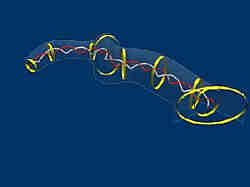Researchers from the University of Chicago have identified a gene defect that causes the development of leukemia in children with Down syndrome. The discovery, scheduled for Advance Online Publication on Nature Genetics’s website on 12 August, could speed diagnosis and provide a new target for therapy.
Children with Down syndrome are 10 to 20 times as likely as unaffected children to develop leukemia. They most commonly develop a type known as acute megakaryoblastic leukemia (AMKL), wh

Rich and Inspiring Experience with NGC 300 Images from the ESO Science Data Archive
A series of wide-field images centred on the nearby spiral galaxy NGC 300, obtained with the Wide-Field Imager (WFI) on the MPG/ESO 2.2-m telescope at the La Silla Observatory, have been combined into a magnificent colour photo.
These images have been used by different groups of astronomers for various kinds of scientific investigations, ranging from individual stars and nebulae in NGC 300, to distant gal
A gene thought to keep a single X chromosome turned on in mice plays no such role in humans, Johns Hopkins researchers report in the August issue of the American Journal of Human Genetics.
The finding is likely to relegate the disproven gene to relative obscurity, at least in humans, says Barbara Migeon, M.D., of the McKusick-Nathans Institute of Genetic Medicine, whose laboratory found the human version of the gene in 2001. It also moves the search for the gene from the X chromosome to the

Researchers at Case Western Reserve University have discovered kinks in aggrecan, a widely studied protein at the submolecular root of arthritis, a finding that brings scientists closer toward new drugs and other interventions to prevent or alleviate the disease. “Aggrecan acts to organize and densely pack sugar molecules that give cartilage its resilience,” said Steven Eppell, an assistant professor of biomedical engineering and director of the Nanoscale Orthopedic Biomaterials Labo
Studies might improve understanding of leading cause of mental retardation in girls By studying gene mutations in patients with the complex set of behavioral and neurological symptoms that accompany Rett syndrome, Howard Hughes Medical Institute investigator Huda Zoghbi and her colleagues at Baylor College of Medicine have designed a mouse model that faithfully recapitulates the disease down to its distinctive hand-wringing behavior. The development of the mouse, reported in the July
After 40 years of searching for the photoreceptor that controls multiple vital processes in fungi, researchers at UT Southwestern Medical Center at Dallas have discovered the protein that triggers this phenomenon.
Light regulates several physiological processes in fungi, including their ability to produce spores and the synchronization of their internal biological clocks, but their photoreceptors – receptors that are sensitive to light and are essential for most ongoing processes – were not